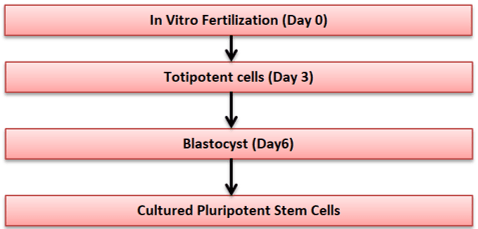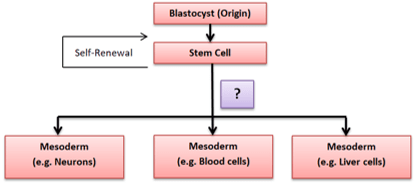This set of Tissue Engineering Multiple Choice Questions & Answers (MCQs) focuses on “Embryonic Stem Cells”.
1. What does the following diagram depict?

a) Derivation of human embryonic cells
b) Derivation of human hepatocytes
c) Derivation of human cardiac cells
d) Derivation of carcinogenic cells
View Answer
Explanation: The sperm and egg are melded in-vitro, on the third day from fertilization the developing embryo begins to separate into cells called totipotent cells. On the fifth day from treatment, the blastocyst is shaped, from which the inward cell mass goes about as the wellspring of embryonic foundational microorganisms. These are then refined on a cell culture plate with proper media and ideal conditions.
2. Embryonic stem cells are derived from the ________ of the blastocyst.
a) inner cell mass
b) ectoderm
c) blastocoel
d) mesoderm
View Answer
Explanation: Developing cells in the research center is known as cell culture. Human embryonic Stem cells (hESCs) are produced by moving cells from a preimplantation-organize developing life into a plastic research center culture dish that contains a supplement soup known as culture medium. The cells gap and spread over the outside of the dish.
3. Embryonic stem cells are _________
a) pluripotent
b) small
c) large
d) medium-sized
View Answer
Explanation: Embryonic stem cells are pluripotent. They can give rise to cells from all three germ layers even after being grown in culture for a long time.
4. The derivation of mouse ES cells was first reported in 1988.
a) TRUE
b) FALSE
View Answer
Explanation: In the year 1981, Mouse Embryonic Stem cells were derived for the first time. In the year 1998, Human Embryonic Stem cells were derived for the first time.
5. What property of stem-cells has been depicted in this diagram?

a) Self-renewal
b) Division
c) Pluripotency
d) Metastasis
View Answer
Explanation: During the gastrulation period the single-layered blastula develops into a trilaminar (three-layered) structure called gastrula. These layers are called germ layers, ectoderm, mesoderm and ectoderm. These layers give rise to different kinds of cells with different functionalities.
6. Human ES cell lines are derived from embryos produced by in vitro fertilization (IVF).
a) TRUE
b) FALSE
View Answer
Explanation: Human ES cell lines are gotten from developing embryos created by in vitro fertilization (IVF), a procedure wherein oocytes and sperm are set together to enable treatment to occur in a culture dish.
7. Human ES cells also have the potential to provide an unlimited amount of tissue for transplantation therapies to treat a wide range of degenerative diseases.
a) TRUE
b) FALSE
View Answer
Explanation: Human ES cells likewise can possibly give a boundless measure of tissue for transplantation treatments to treat a wide scope of degenerative sicknesses. Some significant human ailments are brought about by the passing or brokenness of one or a couple of cell types, e.g., insulin-creating cells in diabetes or dopaminergic neurons in Parkinson’s ailment. The substitution of these cells could offer a long-lasting treatment for these disarranges.
8. When was the first derivation of a human ES cell line (SCNT-hES-1)?
a) March 2004
b) March 2019
c) March 1950
d) March 1980
View Answer
Explanation: A group from South Korea was the first to report about the derivation of the human embryonic cell line (SCNT-hEs-1), in the year 2004. This was done using the somatic-cell nuclear-transfer (SCNT) technique.
9. ________ is the technique used to detect genetic disorders.
a) Preimplantation genetic diagnosis (PGD)
b) Gene therapy
c) Cell therapy
d) Proliferation
View Answer
Explanation: New human ES cell lines were set up from developing embryos with a hereditary issue, which were identified during the act of preimplantation genetic diagnosis (PGD). These new cell lines may give a superb in vitro model for concentrates on the impacts that the hereditary transformations have on cell expansion and separation.
Sanfoundry Global Education & Learning Series – Tissue Engineering.
To practice all areas of Tissue Engineering, here is complete set of 1000+ Multiple Choice Questions and Answers.
If you find a mistake in question / option / answer, kindly take a screenshot and email to [email protected]
- Check Biotechnology Books
- Check Tissue Engineering Books
- Apply for Biotechnology Internship
- Practice Biotechnology MCQs
